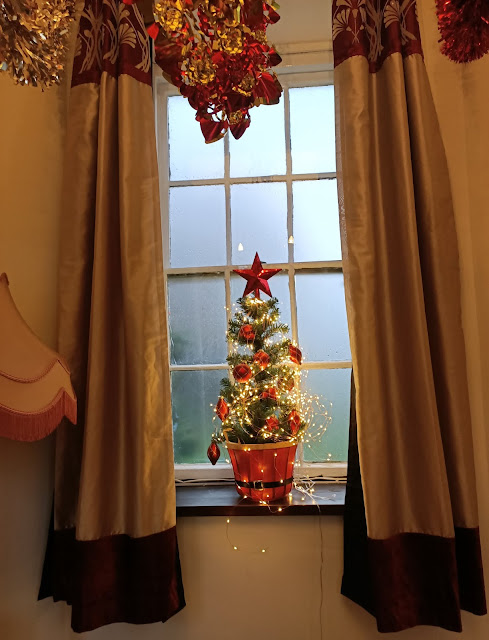 |
The south elevation, with the Heras barrier in its new position
|
It’s been
quite an unsettled week, weather-wise in the gardens at Betley Court. We’re in
the midst of a thunder storm as I type, but between the storms, the weather has
been blisteringly hot, giving us the chance to get many things done on the
house and grounds. Shane has been working on the garage yard, between visits to
check up on the contractors and their excavation finds as they clear the cellar
of burnt debris. The temple down by the car park needed attention, and is now
looking smart after Shane’s repairs and a tidy up.
 |
The temple, during repair work
|
Its good to see the car park
coming together, a sign that some things are getting back to normal.
Having sown
grass and wildflower seeds during May, which had drier than usual conditions, I’m
quite relieved we’re having more rain. Even if it means Shane and Nigel are
having to keep a keen eye on the height of the water behind the dam! No one
wants a repeat of last October’s flooding when Tanhouse Brook came over the top! The new grass and wildflowers seedlings are enjoying the nourishing
mix of rain and sunshine and growing really well.
 |
Our new woodland grasses and wildflower area, down by the visitors hub
|
This year, we don’t expect
any flowers, we’re just happy to let the plants establish.
All this
hot weather has prompted me to come up with a better solution to the
never-ending watering the plants demand. One of those fancy irrigation systems
you see in upmarket pub gardens is beyond our reach. However, I was taught
about glug-glug bottles at horticultural college. Lo-cost and lo-tech, it’s
the perfect answer to our problem, hopefully! Basically, a glug-glug bottle is
made out of an old pop bottle, fitted with a cheap, plastic, screw-on irrigation
spike.
 |
| An irrigation spike on a glug-glug bottle |
The bottle is then inverted and inserted into the compost of a container
plant. If the compost is dry, water seeps out of the irrigation spike. This
stops the compost drying out, which, from experience is very hard to re-wet if
it is allowed to bake dry. The bottles only need re-filling once a week, compared
with the hours it would take to run around with a watering can.
 |
| Glug-glug bottle, in position, keeping this box cone evenly watered |
Taking of
watering cans, I have to share a photo of the two I use in the gardens. They
used to ‘live’ in the porch of the main house, to be used to water container
plants in the Peace Garden, the forecourt and the formal terrace. We discovered
them after the fire, intact, if a little molten.
 |
| Oh dear! The partially molten watering cans |
They don’t leak, so we
continue to use them. I’m kind of attached to them now – they’re special.
 |
| The chartreuse green leaves of the snowdrop tree |
Something
else that’s special in the garden is our ancient snowdrop tree (Halesia Carolina).
When BBC’s Gardeners Question Time came to town (Feb 2019) we received advice
from Chris Beardshaw and Bunny Guinness on how to propagate this tree. They
suggested a technique called air layering. And although it’s a little late in
the spring, I decided to have a go at air layering today. I used a product
called a
cloning ball.
 |
| Cloning ball in position |
It’s a two-part plastic ball that fits around a
stem and looks a bit like a Kinder Egg capsule. I've seen clever recycled ones on the internet using plastic pate containers, so anyone can have a go. The idea is that you wound the
stem, by removing a half inch layer of bark, dust it with hormone rooting
powder, then fit the cloning ball, filled with sphagnum moss and cutting
compost around the stem.
 |
| Wounding the stem with a disinfected pruning knife |
 |
| Dusting the wounded stem with hormone rooting powder |
There’s a wait of 4 to 8 weeks to see if it works. I’ll
know if it has, when roots start growing around the wound. The clone balls have
one clear hemisphere, so I’ll be able to see the roots growing, if I'm successful. Then I can snip off the stem, under the new root ball, and plant. Voila! a new snowdrop tree!
 |
| Our gnarly, old Halesia carolina, with cloning balls in situ |
Air layering is an ancient technique, going back some 4,000 years. The greatest exponents of air layering are the bonsai growers of Japan, but the technique is widely used in agriculture - for example, for propagating 'seedless' type citrus fruits. Its a clever way to propagate a plant you value, and saves many years compared with growing from seed.
One final
bit of good news, for the Betley Court family at least. Our contractors
have agreed to move back the Heras fencing (those bog-standard fencing panels
that appear around building sites) to the top of the terrace on the south side
of the building.
 |
| The Heras fence panels, moved to the top of the terrace. It feels a little less imposing than it did, and we'll be able to maintain that part of the garden more easily now. |
It feels like a victory, albeit a small one. It’ll make no
difference to the village side of the house, but for those of us that live, work
and enjoy the grounds, the retreat of the fence is a sign that things are going in the right direction.
I’m looking forward to tidying up the steps, cutting back overgrown plants and putting
in some flowers. Tidy is good.
As Lockdown
eases, take care of yourselves
All best
wishes
Ladybird Su














Comments
Post a Comment